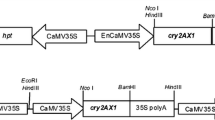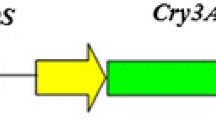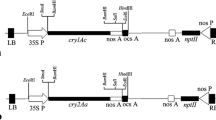Abstract
High levels of expression of the cry1Ac gene from Bacillus thuringiensis cannot be routinely achieved in transgenic plants despite modifications made in the gene to improve its expression. This has been attributed to the instability of the transcript in a few reports. In the present study, based on the genetic transformation of cotton and tobacco, we show that the expression of the Cry1Ac endotoxin has detrimental effects on both the in vitro and in vivo growth and development of transgenic plants. A number of experiments on developing transgenics in cotton with different versions of cry1Ac gene showed that the majority of the plants did not express any Cry1Ac protein. Based on Southern blot analysis, it was also observed that a substantial number of lines did not contain the cry1Ac gene cassette although they contained the marker gene nptII. More significantly, all the lines that showed appreciable levels of expression were found to be phenotypically abnormal. Experiments on transformation of tobacco with different constructs expressing the cry1Ac gene showed that in vitro regeneration was inhibited by the encoded protein. Further, out of a total of 145 independent events generated with the different cry1Ac gene constructs in tobacco, only 21 showed expression of the Cry1Ac protein, confirming observations made in cotton that regenerants that express high levels of the Cry1Ac protein are selected against during regeneration of transformed events. This problem was circumvented by targeting the Cry1Ac protein to the chloroplast, which also significantly improved the expression of the protein.






Similar content being viewed by others
References
Arumugam N, Gupta V, Jagannath A, Mukhopadhyay A, Pradhan AK, Burma PK and Pental D 2007 A passage through in vitro culture leads to efficient production of marker-free transgenic plants in Brassica juncea using the Cre–loxP system. Transgenic Res. 16 703–712
Barton KA, Whiteley HR and Yang N-S 1987 Bacillus thuringiensis δ-endotoxin expressed in transgenic Nicotiana tabacum provides resistance to Lepidopteran insects. Plant Physiol. 85 1103–1109
Bhullar S, Datta D, Advani S, Chakravarthy S, Gautam T, Pental D and Burma PK 2007 Functional analysis of cauliflower mosaic virus 35S promoter: re-evaluation of the role of subdomains B5, B4 and B2 in promoter activity. Plant Biotech. J. 5 696–708
Bradford MM 1976 A rapid and sensitive method for the quantification of microgram quantities of protein utilizing the principle of protein-dye binding. Anal. Biochem. 72 248–254
Chakrabarti SK, Lutz KA, Lertwiriyawong B, Svab Z and Maliga P 2006 Expression of the cry9Aa2 B.t. gene in tobacco chloroplasts confers resistance to potato tuber moth. Transgenic Res. 15 481–488
Chaudhary B, Kumar S, Prasad KVSK, Oinam GS, Burma PK and Pental D 2003 Slow desiccation leads to high-frequency shoot recovery from transformed somatic embryos of cotton (Gossypium hirsutum L. cv. Coker 310FR). Plant Cell Rep. 21 955–960
Corbin DR, Grebenok RJ, Ohnmeiss TE, Greenplate JT and Purcell JP 2001 Expression and chloroplast targeting of cholesterol oxidase in transgenic tobacco plants. Plant Physiol. 126 1116–1128
Dai Z, Hooker BS, Quesenberry RD and Thomas SR 2005 Optimization of Acidothermus cellulolyticus endoglucanase (E1) production in transgenic tobacco plants by transcriptional, post-transcription and post-translational modification. Transgenic Res. 14 627–643
Dey N and Maiti IB 1999 Structure and promoter/leader analysis of mirabilis mosaic virus (MMV) full-length transcript promoter in transgenic plants. Plant Mol. Biol. 40 771–782
Diehn SH, De Rocher EJ and Green PJ 1996 Problems that can limit the expression of foreign genes in plants: lessons to be learned from B.t. toxin genes; in Genetic engineering (ed) JK Setlow (Plenum Press) pp. 83–99
Duret L and Mouchiroud D 1999 Expression pattern and, surprisingly, gene length shape codon usage in Caenorhabditis, Drosophila, and Arabidopsis. Proc. Natl. Acad. Sci. USA 96 4482–4487
Hajdukiewicz P, Svab Z and Maliga P 1994 The small versatile pPZP family of Agrobacterium binary vectors for plant transformation. Plant Mol. Biol. 25 989–994
Jagannath A, Bandyopadhyay P, Arumugam N, Gupta V, Burma PK and Pental D 2001 The use of a Spacer DNA fragment insulates the tissue-specific expression of a cytotoxic gene (barnase) and allows high-frequency generation of male sterile lines in Brassica juncea L. Mol. Breed. 8 11–23
Jefferson RA, Kavanagh TA and Bevan MW 1987 GUS fusion: beta-glucuronidase as a sensitive and versatile gene fusion marker in higher plants. EMBO J. 6 3901–3907
Karim S, Aronsson H, Ericson H, Pirhonen M, Leyman B, Welin B, Mantyla E, Palva ET, Dijck PV and Holmstrom KO 2007 Improved drought tolerance without undesired side effects in transgenic plants producing trehalose. Plant Mol. Biol. 64 371–386
Kay R, Chan A, Daly M and McPherson J 1987 Duplication of CaMV 35S promoter sequences creates a strong enhancer for plant genes. Science 236 1299–1304
Kim EH, Suh SE, Park BS, Shin KS, Kweon SJ, Han EJ, Park S-H, Kim YS and Kim J-K 2009 Chloroplast-targeted expression of synthetic cry1Ac in transgenic rice as an alternate strategy for insect pest protection. Planta 230 397–405
Kranthi KR, Naidu S, Dhawad CS, Tatwawadi A, Mate K, Patil E, Bharose AA, Behere GT, Wadaskar RM and Kranthi S 2005 Temporal and intra-plant variability of Cry1Ac expression in Bt-cotton and its influence on the survival of the cotton bollworm, Helicoverpa armigera (Hübner) (Noctuidae: Lepidoptera). Curr. Sci. 89 291–298
Kumar S, Birah A, Chaudhary B, Burma PK, Gupta GP and Pental D 2005 Plant codon optimized cry genes of Bacillus thuringiensis can be expressed as soluble proteins in Escherichia coli BL21 codon plus strain as NusA-Cry protein fusions. J. Invertebr. Pathol. 88 83–86
Lee L-Y and Gelvin SB 2008 T-DNA binary vectors and systems. Plant Physiol. 146 325–332
Maiti IB, Gowda S, Kiernan J, Ghosh SK and Shepherd RJ 1997 Promoter/leader deletion analysis and plant expression vectors with the figwort mosaic virus (FMV) full length transcript (FLt) promoter containing single or double enhancer domains. Transgenic Res. 6 143–156
Perlak FJ, Deaton RW, Armstrong TA, Fuchs RL, Sims SR, Greenplate JT and Fischhoff DA 1990 Insect Resistant cotton plants. Bio/Technology 8 939–943
Rai M, Datta K, Parkhi V, Tan J, Oliva N, Chawla HS and Datta SK 2007 Variable T-DNA linkage configuration affects inheritance of carotenogenic transgenes and carotenoid accumulation in transgenic Indica rice. Plant Cell Rep. 26 221–231
Rocher EJD, Vargo-Gogola TC, Diehn SH and Green PJ (1998) Direct evidence for rapid degradation of Bacillus thuringiensis toxin mRNA as a cause of poor expression in plants. Plant Physiol. 117 1445–1461
Rogers SO and Bendich AJ 1994 Extraction of total cellular DNA from plants, algae and fungi; in Plant molecular biology manual (eds.) SB Gelvin and RA Schilperoort (Dordrecht: Kluwer Academic Press) pp D1:1–8
Sachs ES, Benedic JH, Stelly DM, Taylor JF, Altman DW, Berberich SA and Davis SK 1998 Expression and segregation of genes encoding Cry1Ac insecticidal proteins in cotton. Crop Sci. 38 1–11
Svab Z, Hajdukiewicz P and Maliga P 1995 Generation of transgenic tobacco plants by cocultivation of leaf disks with Agrobacterium pPZP binary vectors; in Methods in plant molecular biology (eds) Maliga P, Klessing DF, Cashmore AR, Gruissem W and Varner JE (New York: Cold Spring Harbor Laboratory Press), pp. 55–77
Wong EY, Hironaka CM and Fischhoff DA 1992 Arabidopsis thaliana small subunit leader and transit peptide enhance the expression of Bacillus thuringiensis proteins in transgenic plants. Plant Mol. Biol. 20 81–93
Zhang J, Cai L, Cheng J, Mao H, Fan X, Meng Z, Chan KM, Zhang H, Qi J, Ji L and Hong Y 2008 Transgene integration and organization in cotton (Gossypium hirsutum L.) genome. Transgenic Res. 17 293–306
Acknowledgements
This work was supported by a grant-in-aid (No.BT/AB/NP/07/Cotton/2005) from the Department of Biotechnology, India. PR, SK, PK, GK and BC acknowledge fellowships from Council of Scientific and Industrial Research, India, and University Grants Commission, India.
Author information
Authors and Affiliations
Corresponding author
Additional information
Corresponding editor: Imran Siddiqi
[Rawat P, Singh AK, Ray K, Chaudhary B, Kumar S, Gautam T, Kanoria S, Kaur G, Kumar P, Pental D and Burma PK 2011 Detrimental effect of expression of Bt endotoxin Cry1Ac on in vitro regeneration, in vivo growth and development of tobacco and cotton transgenics.J. Biosci. 36 363–376] DOI 10.1007/s12038-011-9074-5
Supplementary materials pertaining to this article are available on the Journal of Biosciences Website at http://www.ias.ac.in/jbiosci/Jun2011/pp363–376/suppl.pdf
Electronic supplementary material
Below is the link to the electronic supplementary material.
ESM 1
(PDF 49.3 kb)
Rights and permissions
About this article
Cite this article
Rawat, P., Singh, A.K., Ray, K. et al. Detrimental effect of expression of Bt endotoxin Cry1Ac on in vitro regeneration, in vivo growth and development of tobacco and cotton transgenics. J Biosci 36, 363–376 (2011). https://doi.org/10.1007/s12038-011-9074-5
Received:
Accepted:
Published:
Issue Date:
DOI: https://doi.org/10.1007/s12038-011-9074-5




